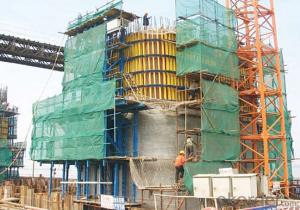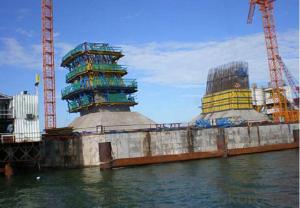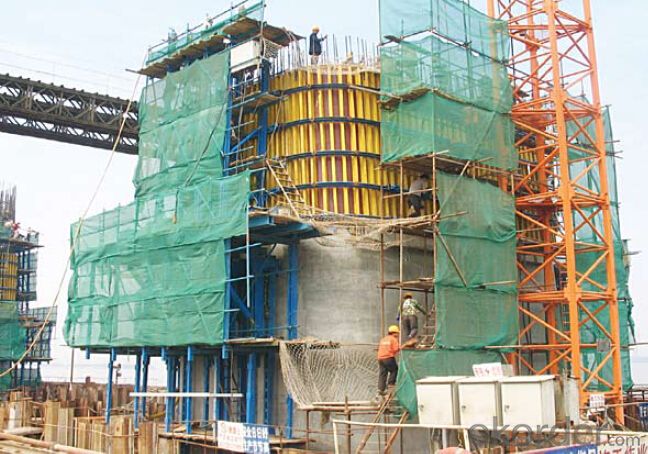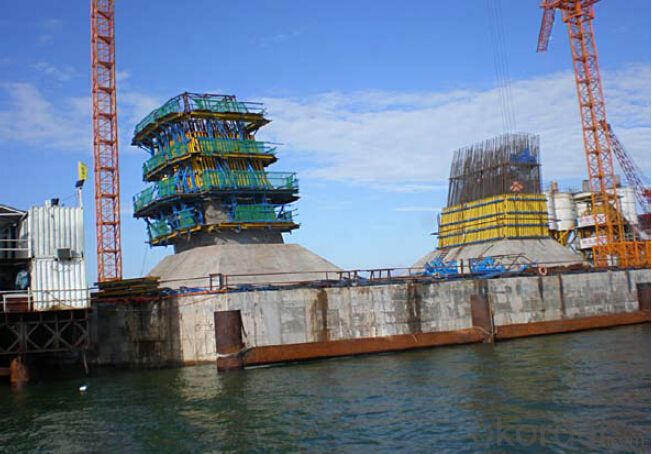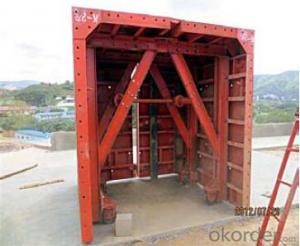Auto-climbing Bracket ACB100 for formwork and scaffolding system
- Loading Port:
- Tianjin
- Payment Terms:
- TT OR LC
- Min Order Qty:
- 50 m²
- Supply Capability:
- 1000 m²/month
OKorder Service Pledge
OKorder Financial Service
You Might Also Like
Auto-climbing Bracket ACB100 & ACB50
The power of the auto-climbing formwork is the hydraulic system, which includes the oil cylinder
and two commutators. The commutators can control the climbing of climbing rail and the bracket.
The steel rail and the bracket can inter-climbing, so the whole system will climb up steadily.
Cranes are not needed during the construction. It’s easy to operate, highly efficient and safe. It’s
the best choice for the construction of high buildings and bridges.
There are mainly two types of standard auto-climbing brackets, ACB-50 and ACB-100, the figure
means the push power of cylinder with unit of KN.
Characteristics:
◆ Perfect load bearing anchor system
Anchor system is the most important supporting part. The system is made of five parts shown
below. Thereinto, tensile bolt, V-climbing cone and washer can be taken out for reusing after the
concrete pouring finished.There are two kinds of anchor systems,A & B. A is matched with single
anchor shoe and B is matched with double anchor shoe.
◆ Crane-independent
Crane-independent forming, striking and climbing speeds up the work procedures on the
construction site and also makes them independent of each other. This means the planned
sequences can be maintained along with guaranteeing high productivity levels. The crane can
therefore be used for other tasks.
Hydraulic system is mainly made of two commutators,
oil cylinder and power distribution system.The
commutators can control the climbing of climbing rail
and bracket.
◆ High bearing capacity and safe
The stable working platforms are able to carry large loads, e.g. the storage of reinforcing steel
for the next climbing section. Generously-sized working platforms, the well thought-out design for
handling very high wind loads and the patented control function of the climbing mechanism are
some of the special details contained within the comprehensive safety concept.
◆ Platforms adjusted to suit the angle of inclination
The horizontal working areas thus created provide safe and comfortable conditions for
reinforcement work, shuttering and striking, concreting and finishing.
◆ The ACB formwork system can climb not only vertically but also slantways, the largest angle is
18 degrees.
◆ The system can climb up wholly or separately. The climbing process is steady, synchronous
and safe.
◆ The bracket will not fall to the ground until the construction is finished, the field will be saved
and the impacting breakage will be reduced (especially the panel).
◆ The system will furnish omnidirectional platform, the construction organizations don’t need to
set up additional operation platform.
◆ The error of structure construction is small and easy to correct.
◆ The climbing speed is fast, the construction course will be quickened.
◆ The formwork can climb itself and cleaning work can be done in the same situs , the used times
of tower crane will be greatly reduced.

- Q: Can steel formwork be used for precast concrete wall panels?
- Precast concrete wall panels can indeed utilize steel formwork. Steel formwork boasts numerous advantages in precast concrete construction. With its high strength, durability, and dimensional accuracy, steel formwork guarantees the production of top-quality wall panels. Moreover, steel formwork can be easily reused multiple times, presenting a cost-effective solution. Additionally, its installation process is quick and efficient, leading to reduced construction time. The malleability of steel formwork allows for the creation of wall panels in various shapes and sizes, accommodating the design requirements of diverse projects. Consequently, steel formwork emerges as a fitting choice for precast concrete wall panels, offering an array of benefits in terms of strength, durability, efficiency, and cost-effectiveness.
- Q: Are there any environmental considerations when using steel formwork?
- Using steel formwork in construction projects raises several environmental considerations. First and foremost, the production of steel leaves a significant carbon footprint. Greenhouse gas emissions are generated during the extraction and processing of raw materials, such as iron ore and coal. Moreover, the manufacturing process itself requires a substantial amount of energy, further contributing to carbon emissions. In addition, the transportation of steel formwork systems has a negative environmental impact. The movement of heavy steel panels and other components increases fuel consumption and emissions, particularly for long distances. Furthermore, steel formwork is typically non-renewable and non-recyclable. Once it reaches the end of its useful life, it often ends up in landfills, contributing to waste accumulation and environmental pollution. However, it is important to note that steel formwork does have some environmental advantages compared to other materials. For instance, it can be reused multiple times, reducing the need for new materials and minimizing waste generation. Its durability and strength also contribute to a longer lifespan and less frequent replacements, which in turn reduces overall resource consumption. To mitigate the environmental impact of using steel formwork, various measures can be taken. These include optimizing transportation routes to reduce fuel consumption, implementing energy-efficient manufacturing processes, and promoting the recycling of steel formwork components at the end of their life. Additionally, exploring alternative formwork materials, such as recycled or sustainable options, can also help address the environmental considerations associated with steel formwork usage.
- Q: Can steel formwork be used in high-rise construction?
- High-rise construction can utilize steel formwork effectively. Steel formwork possesses numerous advantages that render it suitable for high-rise construction undertakings. The first advantage lies in its robustness and durability, enabling it to withstand the immense pressure exerted during concrete placement in towering structures. This characteristic ensures stability and rigidity, thereby guaranteeing the formwork's integrity throughout the construction process. Moreover, steel formwork exhibits versatility, allowing for easy customization to meet the specific demands of high-rise buildings. Its adaptability permits effortless adjustment and reconfiguration, accommodating diverse shapes and sizes, ultimately facilitating flexible and efficient construction. Additionally, steel formwork yields a smooth and superior finish on concrete surfaces, an essential attribute for high-rise edifices that necessitate aesthetic appeal. Furthermore, steel formwork possesses the advantage of reusability, thereby reducing overall construction costs. Unlike conventional timber formwork, steel formwork can be disassembled and reused multiple times, presenting a cost-effective solution for high-rise endeavors. This not only diminishes waste but also promotes sustainability within the construction industry. Lastly, steel formwork enhances safety during high-rise construction. Its strength and stability minimize the prospect of accidents and collapses, thereby cultivating a safer working environment for construction workers. To conclude, steel formwork is undeniably suitable for high-rise construction due to its strength, versatility, cost-effectiveness, and safety features. It stands as a dependable and efficient solution that caters to the unique requirements of towering structures.
- Q: What are the different types of formwork spacers used in steel formwork?
- Various types of formwork spacers are commonly utilized in steel formwork. These spacers play a crucial role in maintaining the desired spacing between the formwork and reinforcement, thus ensuring the structural integrity of the concrete structure. Here, we present a range of formwork spacers frequently employed in steel formwork: 1. Plastic Spacers: Due to their lightweight nature, durability, and easy installation, plastic spacers are extensively employed in steel formwork. They are typically crafted from top-notch plastic materials and come in diverse shapes and sizes to accommodate different reinforcement requirements. 2. Steel Spacers: Steel spacers are another prevalent type of formwork spacer used in steel formwork applications. Constructed from high-strength steel, they possess the capacity to withstand heavier loads. Steel spacers prove ideal for heavy-duty applications that necessitate added strength and durability. 3. Rubber Spacers: In steel formwork, rubber spacers are employed to provide a cushioning effect and prevent direct contact between the reinforcement and the formwork. These spacers are suitable for scenarios where vibration or movement is anticipated, as they efficiently absorb shocks and minimize the risk of damage. 4. Concrete Spacers: Concrete spacers primarily find utility in precast concrete applications. Comprised of concrete, they act as support structures, ensuring the correct spacing between the formwork and reinforcement is maintained. Concrete spacers are not only durable and easy to install but also offer exceptional stability during the casting process. 5. Combination Spacers: Combination spacers are versatile in nature, incorporating various materials such as plastic and steel to provide enhanced strength and stability. These spacers are designed to meet specific project requirements and offer a cost-effective solution for various steel formwork applications. To guarantee optimal performance and safety, it is imperative to select the appropriate formwork spacer type based on the project's specific requirements, encompassing load capacity, spacing needs, and environmental conditions. Seeking guidance from a structural engineer or construction professional can ensure the correct selection and installation of formwork spacers.
- Q: What are the considerations when designing steel formwork for underground parking structures?
- When designing steel formwork for underground parking structures, several key considerations should be taken into account. Firstly, the formwork must be able to withstand the heavy loads and pressures exerted by the surrounding soil and any potential water infiltration. It is crucial to ensure the strength, stability, and durability of the formwork system to prevent any structural failures or collapses. Additionally, careful attention should be paid to the formwork's waterproofing capabilities. Adequate waterproofing measures, such as the use of sealants or membranes, must be incorporated to protect the structure against potential water ingress, which could lead to corrosion and long-term damage. Moreover, the design should allow for efficient and safe construction. This includes considering factors such as ease of assembly and disassembly, ensuring proper access and working space for construction workers, and incorporating appropriate safety measures to prevent accidents during the formwork installation and removal processes. Lastly, the formwork design should also take into consideration the desired architectural and aesthetic elements of the parking structure. This may involve incorporating specific finishes, textures, or patterns on the exposed concrete surfaces, which can enhance the overall visual appeal of the underground parking facility. Overall, the considerations when designing steel formwork for underground parking structures revolve around ensuring structural integrity, waterproofing capabilities, construction efficiency, safety, and meeting the desired architectural requirements.
- Q: How does steel formwork compare to aluminum formwork in terms of performance?
- Steel and aluminum formwork are commonly used materials in the construction industry to create temporary molds or structures that hold concrete in place until it becomes solid. When comparing these materials, it is important to consider their performance aspects. In terms of performance, steel formwork is known for its strength and durability. It can withstand heavy loads and rough handling, making it suitable for heavy-duty applications. Steel formwork also maintains its shape during the concrete pouring process, resulting in accurate finishes. It can be easily customized to meet project requirements. On the other hand, aluminum formwork is preferred for its lightweight nature. It is easy to handle, transport, and assemble, reducing labor costs and construction time. It also has excellent corrosion resistance, making it suitable for coastal areas or humid environments. Additionally, aluminum formwork provides a smooth surface finish on the concrete, requiring minimal treatment. The choice between steel and aluminum formwork depends on the specific project requirements. Steel formwork is ideal for projects with heavy loads or high reuse needs due to its strength and durability. On the other hand, aluminum formwork is a better choice for projects that require quick assembly, easy handling, and a smooth surface finish. Ultimately, the selection of formwork should be based on a careful evaluation of the project's needs, budget, timeline, and other factors such as cost, maintenance, and environmental impact.
- Q: What are the different types of formwork bracing used in steel formwork?
- In steel formwork, there are various types of formwork bracing, each with its own unique features and benefits. Here are some of the most commonly used types: 1. Adjustable Steel Bracing: This bracing consists of adjustable steel tubes or rods that can be extended or retracted easily to the desired length. It allows for quick and easy installation and adjustment, making it ideal for projects with varying formwork heights. 2. Cross Bracing: Cross bracing involves diagonal steel members placed to create an "X" shape between vertical supports. It provides lateral stability to the formwork system and helps prevent buckling or deformation. 3. Tie Rod Bracing: Tie rod bracing uses threaded steel rods connected through formwork panels to provide extra strength and stability. It is commonly used in large-scale formwork systems that need to support high loads. 4. External Bracing: To increase stability against wind forces, taller formwork structures often use external bracing. Steel members are installed on the exterior side of the formwork system to resist lateral movement and maintain structural integrity. 5. Kickers: Kickers are diagonal bracing elements installed between formwork panels and the ground or a solid anchor point. They transfer lateral forces and prevent the formwork from tilting or collapsing. 6. Strut Bracing: Strut bracing involves placing steel struts or props vertically between the formwork panels and the ground. It provides additional support to prevent horizontal movement and ensure the stability of the formwork system. 7. Flying Bracing: When formwork needs support from above, such as in bridge construction or overhead structures, flying bracing is used. Bracing elements are suspended from overhead supports to provide stability and prevent formwork deformation. Each type of formwork bracing offers advantages and is chosen based on specific project requirements, including formwork height and size, expected loads, and site conditions. A combination of different bracing types may also be used to ensure optimal stability and safety.
- Q: Can steel formwork be used for concrete beams with varying cross-sections?
- Certainly, concrete beams with varying cross-sections can be constructed using steel formwork. The versatility of steel formwork allows for easy adjustment and customization to accommodate different shapes and sizes of concrete beams. This flexibility in formwork design enables the creation of intricate and irregular shapes. Moreover, steel formwork exhibits exceptional strength and durability, making it well-suited for supporting the weight and pressure exerted by concrete during the pouring and curing stages. In conclusion, steel formwork is an excellent option for constructing concrete beams with varying cross-sections, offering adaptability, strength, and reliability.
- Q: Can steel formwork be used in tunnel construction?
- Yes, steel formwork can be used in tunnel construction. It is a durable and strong material that can withstand the pressure and weight of the soil and concrete in tunnel construction. Its versatility allows it to be easily customized and assembled to match the shape and size of the tunnel, making it an ideal choice for this type of construction project.
- Q: Can steel formwork be used for elevated slabs?
- Indeed, elevated slabs can be constructed using steel formwork. Steel formwork serves as a flexible and long-lasting choice for the construction of elevated slabs. It presents a robust and inflexible framework capable of withstanding the weight of the slab and any additional burdens. Moreover, steel formwork offers the added benefit of being reusable, thereby enabling savings in cost and enhancing efficiency in construction endeavors. Furthermore, steel formwork can be effortlessly modified and tailored to meet specific design requisites, rendering it suitable for diverse kinds of elevated slabs. In summary, due to its strength, durability, reusability, and adaptability, steel formwork stands as a dependable alternative for the construction of elevated slabs.
Send your message to us
Auto-climbing Bracket ACB100 for formwork and scaffolding system
- Loading Port:
- Tianjin
- Payment Terms:
- TT OR LC
- Min Order Qty:
- 50 m²
- Supply Capability:
- 1000 m²/month
OKorder Service Pledge
OKorder Financial Service
Similar products
Hot products
Hot Searches
